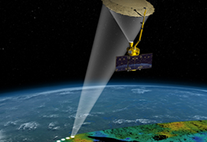CliSAP researchers receive half a million euros for satellite mission
29 January 2015, by Franziska Neigenfind

Photo: NASA
The European Union will provide roughly half a million euros in funding to support Hamburg-based sea ice research ...
Arctic sea ice is extremely sensitive to climate changes, making it an important early warning system for changes in the Earth’s climate. To date, however, it hasn’t been possible to reliably estimate regional changes in the ice mass, since no consistent measurements for the ice thickness were available.
“The new SMAP satellite – originally developed to measure soil moisture on land – will now for the first time deliver detailed data on ice thickness,” said Lars Kaleschke, Professor at Universität Hamburg’s Center for Earth System Research and Sustainability. With the help of a giant six-meter-diameter reflector antenna, it can accurately measure heat radiation in the long-wavelength microwave range. This information can then be used to determine ice thickness.
In addition, SMAP has an active radar system with a spatial resolution of three kilometers, which can send fine-scale data. “This is particularly useful when it comes to measuring ice thickness, which can vary greatly over a given area,” said Kaleschke. Previously the resolution of the satellite data was lower, providing just one datapoint for an area of 35 by 35 meters.
CliSAP will enjoy priority access to NASA data
In the SPICES project (short for space-borne observations for detecting and forecasting sea ice cover extremes), Kaleschke and his team will develop methods for interpreting the data SMAP transmits. “To obtain concrete information from the data, first of all we analyze the figures using physical calculation models,” explains Kaleschke. As a member of the exclusive “Early Adopters” group, he will have priority access to NASA’s satellite data.
The processed data will then be used by Dirk Notz and his group at the Max Planck Institute for Meteorology to provide, for example, more precise initial conditions for computer models, an important prerequisite for predicting future ice cover. Such simulations could make it possible to draw conclusions about the seasonal temperature trends in Central Europe, since ice cover has a major impact on heat exchange between the ocean and the air.
Alongside Kaleschke and Notz, researchers from a total of 14 institutions in eight countries are involved in the SPICE project, which will receive three million euros of funding.
SMAP satellite launch and info
